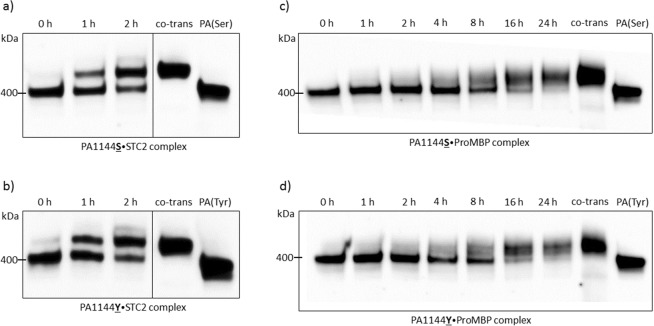Figure 2.
Complex formation of PAPP-A and STC2 or proMBP over time. Supernatants containing PAPP-A with either the serine (PA1144S) or the tyrosine (PA1144Y) variant of the rs7020782 SNP were incubated with STC2 (2a and 2b) or proMBP (2c and 2d) and formed covalent complexes over time (PAPP-A was incubated with STC2 or proMBP for 0, 1, 2, 4, 8, 16, and 24 hours). These protein complexes were visualized with Western blotting using a primary antibody against PAPP-A. A high molecular-weight band appears when complexes are formed (>400 kDa PAPP-A dimer). This figure displays PAPP-A incubated with STC2 from 0 to 2 h solely, since most PAPP-A has complexed with STC2 by this time-point and a potential difference would therefore be visible. Full-length blots and replications are presented in Supplementary Figs 2.1, 2.2. Supernatants from HEK293T cells co-transfected with both PAPP-A and STC2 or PAPP-A and proMBP were included in the Western blot as positive controls (co-trans) showing complexes exclusively. Supernatants from HEK293T cells transfected with PAPP-A alone (Serine variant: PA(Ser) or tyrosine variant: PA(Tyr)) was included as negative controls showing PAPP-A dimers solely. No difference was observed between the two PAPP-A variants in this Western blot analysis.

